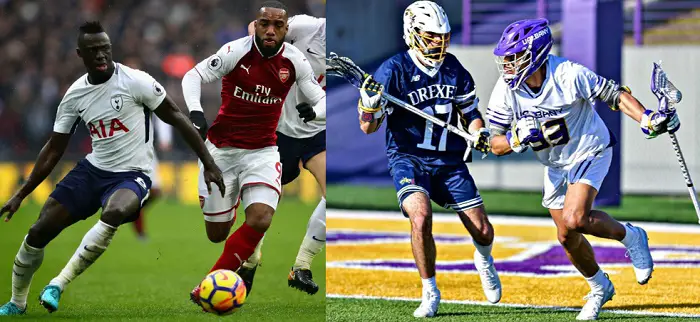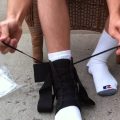*This page may contain affiliate links. When you buy through these links, we may earn a small commission at no extra cost to you.
Football and lacrosse cleats are helpful for the same basic purpose: to provide the players with additional traction on all types of grounds and surfaces- from grassy fields to artificial turfs.
It doesn’t just help in the smooth mobility of the players but also protects them from injury.
The thing you need to care about is football cleats and lacrosse cleats; although it seems to be the same they are not.
They are uniquely designed for their respective game and should not be used in place of one another.

Before we take a look at the differences in detail, let us know about the similarities between the football and lacrosse cleats.
Lacrosse and football cleats should work with precision on the wet, slimy and treacherous ground and also on dry grasses, so everyone needs a plethora of stud options.
Whether it’s a game of lacrosse or football, cleats for both sports come with molded studs where that are constructed in the soles.
You also have the availability of detachable studs, which give the players an option to change them out as and when they want.
Both the sports use cleats made of either synthetic or leather uppers.
They also lay emphasis on the location of all cleats along with the shoe’s outer edge to gain the highest traction at the time of lateral movement.
Football Cleats vs. Lacrosse Cleats
Though similar in a lot of ways, there are some differences present between the cleats for football and lacrosse.
Let’s check them out here so that you can choose the one that suits your game best.
The places where football and lacrosse cleats differ are:
1- Need to breathe
Both the shoes differ in how much airflow they enable around the feet.
Lacrosse shoes are made for higher breathability, while the footballs offer higher protection from the cleats of the other football players at the time of close-quarter contact.
Several lacrosse cleats come decked with mesh vents in the upper for better airflow.
The uppers made of leather offer higher breathability in comparison to synthetic uppers, even where isn’t any vent, which isn’t present on most the football cleats
2- Count the stud
Though the number of differences varies depending on the cleat style and the preference of the player, in general, lacrosse cleats have a greater number of studs in comparison to football cleats.
The general cleat layout for a lacrosse shoe is four at heels and around 6 to 8 in the toe and ball of the foot.
On the contrary, football cleats usually have two studs in the back at the heel and around 5 below the toe and ball of the foot.
3- Ankle heights
Both football and lacrosse offer cleats of varying heights, but the differences are higher in the football ones.
Lacrosse makes use of mid-cuts for resistance and low-cuts for flexibility. The cleat styles of football differ by position.
Because linemen may require higher ankle support, hence they go for high-tops.
Mid-cuts, on the contrary, render support to the ankles along with flexibility, which makes them a perfect option for quarterbacks.
And, the players who need high speed and agility should go for low-cut cleats as they are lighter.
Can You Wear Football Cleats for Lacrosse?
Though football and lacrosse cleats may appear to be the same, there are a lot of differences between the two.
It is therefore not recommended to use football cleats for lacrosse or vice versa.
When buying you should focus on the above-given points, especially when you are planning to give the maximum performance in the game yourself.
Incoming search terms:- football vs lacrosse cleats
- lacrosse vs football cleats
- lacrosse cleats vs football cleats






